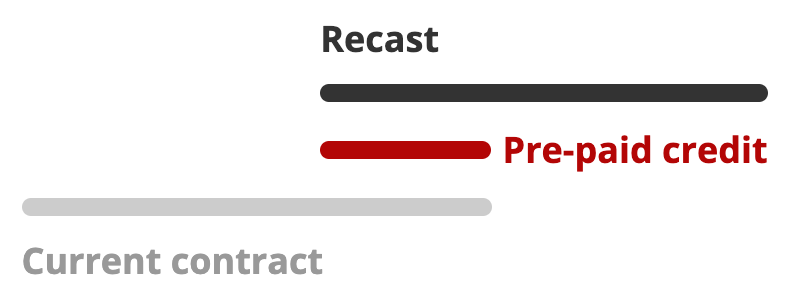Overview
Now that you know how to structure your pricing, build an Order, and configure customer checkout, you have all the tools needed to close your first Order. And if you’ve already closed your first Order, congratulations! You’ve officially converted a prospect to a happy customer. Let’s say they want to update their subscription - maybe they need to add more licenses, or they want to extend their one-year contract for two more years. We support four ways to update an Order after the initial close:- Upgrade
- Renewal
- Recast
- Termination
Upgrade

Upgrade examples
Current contract: Customer has signed a one-year contract for a basic plan, which includes 5 seats at no extra cost.Example A - Add Seats
Example A - Add Seats
Three months in, the customer decides that they need to add 3 more seats to the subscription, so you build this into an upgrade for the remaining 9 months.
What happens to the current contract after the upgrade closes?
This example retains the same Plan from the current contract.The subscription will be an aggregate of entitlements across the current contract and all subsequent upgrades (5 seats from the initial + 3 seats from the upgrade, for a total of 8 seats).Any other contract terms from the current contract will be replaced by the terms defined in the upgrade.Example B - Switch Plans
Example B - Switch Plans
Three months in, the customer wants to upgrade to an advanced plan for the remaining 9 months, which includes 10 seats at no extra cost.
What happens to the current contract after the upgrade closes?
Since a different Plan was selected, the entitlements from the current contract are replaced by the entitlements of the upgraded Plan.Any other contract terms from the current contract will be replaced by the terms defined in the upgrade.What happens to invoices?
The billing schedule of the current contract is replaced by the billing schedule outlined in the upgrade.Renewal

Renewal example
Current contract: Customer has signed a one-year contract with manual renewal terms (must be agreed upon by the buyer). 8 months later, the customer decides that they are happy with their subscription, and are ready to set up a renewal for another year.Total expected renewal spend
The total expected renewal amount is calculated based on the flat renewal cost of the current plan while keeping the same quantity of bricks. Regular discounts that apply to the plan are included in this calculation. However, any one-time bricks purchased in the original order are excluded from the renewal amount, ensuring that only the recurring elements are considered. Likewise, any one-time discounts applied to the original purchase are not factored into the renewal calculation. Included:- plan subscription fee
- additional subscription bricks in that exact quantity
- pre-commitment bricks in that amount
- sales (recurring) discounts on both the plan and any add-on bricks
- one time bricks
- usage bricks with no pre-commitment
- one time discounts on any of the bricks
What happens to the current contract after the renewal closes?
A renewal is a continuation of the customer’s subscription under new dates. The current contract remains active until its end date, after which, the renewal begins.What happens to invoices?
The customer will continue to receive invoices according to the billing schedule of the current contract. Once the renewal begins, the customer will receive invoices according to the billing schedule outlined in the renewal.Recast

Recast examples
Current contract: Customer has signed an upcoming 6-month contract, from March 1st to September 30th.Example A - New Contract Dates
Example A - New Contract Dates
Before the contract start date, they decide that they want the subscription to run from March 15th to October 14th instead, so you build these new dates into a recast.
Example B - Switch Products
Example B - Switch Products
Two weeks in, the customer realizes that one of your other Products is a much better fit for their needs, so you build a recast that replaces their current subscription with the new Product.
What happens to the current contract after the recast closes?
The current contract is considered superseded (replaced by the terms of the recast), essentially rendering it inactive.What happens to invoices?
The billing schedule of the current contract is replaced by the billing schedule outlined in the recast. Any amount from the current contract that the customer has already paid, or has been billed for, will be added to the recast as a prorated discount.Termination

Termination examples
Current contract: Customer has signed a 1-year contract.Example A - Terminate on Renewal Date
Example A - Terminate on Renewal Date
The subscription is set to auto-renew at the end of the current contract.90 days before the renewal date, the customer decides that they no longer want to renew beyond the current contract, so you update the subscription to terminate on the renewal date.
Example B - Terminate on Specific Date
Example B - Terminate on Specific Date
6 months in, the customer still hasn’t implemented the entitlements and asks to terminate the contract at the end of the month.You update the subscription to terminate on the last day of the current month.